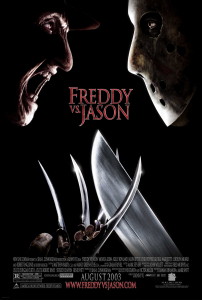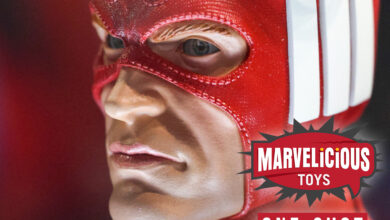The 40 Year-Old-Critic: Freddy vs. Jason (2003)

 In The 40-Year-Old Critic, Venganza Media creator and host Arnie Carvalho recalls a memorable film for each year of his life. This series appears daily on the Venganza Media Gazette.
In The 40-Year-Old Critic, Venganza Media creator and host Arnie Carvalho recalls a memorable film for each year of his life. This series appears daily on the Venganza Media Gazette.
How many times will I review Freddy vs. Jason? It was one of Now Playing Podcast’s earliest reviews as part of our first retrospective series covering the Friday the 13th franchise leading up to the 2009 remake. Even then we planned to revisit the film and look at it from Freddy’s point of view, which we did the following year during the review series leading up to 2010’s A Nightmare on Elm Street.
By now this should be well-trod ground, and what more could I have to say?
Yet the fact that this is the only movie to be covered twice in Now Playing Podcast retrospectives is indicative of its importance — to film in general and to me personally.
Since our 2010 review I’ve spent a lot more time thinking about the crossover. What is it about two franchises coming together that creates such excitement, especially in the “geek” community? I don’t ask this hypothetically. I personally get swept up in the frenzy when two franchises come together, and it doesn’t even matter necessarily if I like them both! The thought of two universes colliding seems to have a geometric, not additive, increase in interest.
I think to some degree it is fan rivalry at its best. For reasons I don’t understand it seems some fans feel the only way to feel good about their fandom is by putting down others. For example, when Firefly was at its zenith a parade of “Joss Whedon Is My Master Now” shirts filled Star Wars conventions, as if to say, “Star Wars used to be cool.” As such, the “my dad can beat up your dad” mentality started to apply to fan groups; “My stormtrooper can beat up your browncoat.”

Freddy vs. Jason — whoever loses, the fans win.
That question of who would win in a fight certainly applies to superheroes. In real life, on screen, and online I’ve heard endless debates about which hero is faster, The Flash or Superman. Who would win in a fight, Superman or The Hulk? It is a curiosity, but the chosen winner usually aligns with the speaker’s fan allegiances.
Certainly, speaking of superheroes, comic books have benefited greatly from the crossover. DC Comics had a major hit with its Justice League in 1961, prompting Marvel Comics to respond with its own super team, The Fantastic Four, a move that inadvertently launched the entire Marvel Universe.
Yet, to me, the crossover seemed relegated to just that medium — the comic book. It seemed comics were pulp enough that you could do anything.
Aliens vs. Predator? Sure.
Robocop vs. Terminator? Why not.
Star Trek and X-Men together, you say? Absolutely.
Even rivals Marvel and DC had several crossover series’ that, for instance, led to Superman meeting Spider-Man or Batman fighting the Hulk.
Despite the success and excitement generated by these crossover comics, the concept was rarely conceptualized on film. Universal Studios had done it in the 1940s, when horror icons Dracula, Frankenstein and the Wolf Man came together for the studio’s “Monster Mash” pictures. But Universal owned each property, and when that series ended, crossovers on screen were scarce.
I can recall two that made an impact on me.

Freddy and Jason aren’t the only names in this cast. Monica Keena (Dawson’s Creek), Katharine Isabelle (Ginger Snaps), and Destiny Child’s Kelly Rowland play teens caught in the middle of the battle royale.
I remember being a young child on vacation with my parents when I saw a trailer for King Kong vs. Godzilla. I had seen numerous Godzilla films, and the 1976 King Kong several times. So the thought of them fighting broke my fragile little mind. I demanded we stay in the hotel room that night so I could watch.
Then, in 1988, Who Framed Roger Rabbit brought together animated characters from Warner Bros., Disney, Turner Entertainment, and more. As I was a teenager, and never really into these characters at my youngest age, the impact was totally lost on me. I saw the film in theaters, thought it was mediocre, and haven’t seen it since.
Beyond those two I can’t think of any groundbreaking crossovers. Some minor ones occurred; such as Star Trek: Generations bringing together cast members from two Trek television series’ (something that had already been done numerous times on Star Trek: The Next Generation, thus lessening the film’s impact). Also, The Monster Squad reassembled the classic Universal Monsters for a kiddie comedy.
But fans wanted more.
So many ideas were teased. Studios knew what we liked, so 1997’s Batman and Robin made sly references to Superman, and 20th Century Fox put an Alien xenomorph skull on a Predator ship in Predator 2. The latter seemed most likely to happen again on film — both franchises were Fox properties in need of a boost. Yet, outside of the Dark Horse comics, nothing materialized for years.
For me, though, more than Aliens and Predators, more than Superman and Batman, Freddy and Jason were the two I wanted to see. Long had the rumor brewed about Hollywood’s (then) top-grossing slashers, Jason Voorhees and Freddy Krueger, going toe-to-toe. I read about it in multiple Fangoria articles in the late 80s and early 90s.
I first saw A Nightmare on Elm Street during a party in 1987, around the time of A Nightmare on Elm Street 3: The Dream Warriors’ release. I found the films so inventive and fun that I rewatched them endlessly, and anxiously awaited each new installment in the series. As detailed during the Now Playing Podcast review, I even cosplayed for the release of Freddy’s Dead: The Final Nightmare. By 2003 I was happy for any new Nightmare, let alone one that pitted villain Freddy against Friday the 13th icon Jason.
I was never as big a fan of the Crystal Lake zombie as I was Freddy, but I did also enjoy the Friday the 13th series. Some of the first R-rated horror I ever saw was Friday the 13th when I came home to find older kids in my house watching it. I tried to join them but the carnage, specifically the decapitation at the end of the 1980 original film, had me fleeing the room. When I finally became a full-fledged horror hound in my early teen years I returned to the franchise when Jason Takes Manhattan was released. While the films lacked the visual panache of the Nightmare series I still enjoyed the films as a guilty pleasure. Over time the series grew in my esteem to be another favorite.

Freddy was killed by fire, but flames don’t slow down Jason.
As such, having both serialized slashers come together would be a dream come true. Or, if done wrong, perhaps a nightmare.
Yet despite the rumors in the horror press and the anticipation by fans such as myself, the killer crossover took 15 years to materialize. Full credit for finally bringing the crossover to screen in the 21st Century must be given to New Line Cinema.
The biggest problem in the 1980s and 1990s was the rights: Jason was owned by Paramount, Freddy was New Line Cinema’s cash cow. The studios tried to work together during the slasher heyday but each wanted to earn 100 percent of the profits by licensing the other’s character. Obviously, that never happened.
Eventually, though, profits started to dry up. Paramount had run Friday the 13th into the ground with crazy concepts like Jason fighting a telekinetic or taking Manhattan. When original Friday creator Sean S. Cunningham wanted to see the franchise continue, specifically with a Freddy crossover, Paramount had no interest. This gave New Line an opportunity. They licensed Jason from Paramount and went to work on Freddy vs. Jason.
While Jason’s creator wanted the crossover, Freddy creator Wes Craven had other ideas. The Springwood Slasher had been given what New Line considered a proper sendoff with 1991’s Freddy’s Dead: The Final Nightmare. But the sequel proved profitable and Craven started planning a return to his iconic franchise. As such, Freddy vs. Jason was put on hold and, instead, Wes Craven’s New Nightmare was made.
Cunningham bided his time, though. In 1993 Jason Goes to Hell: The Final Friday was released and ended with a fan-baiting stinger; Freddy’s glove comes out of the ground and pulls down Jason’s mask. The game was afoot!
We would still have to wait more than a decade for Freddy and Jason to properly share the screen. New Line executives knew the importance of finding the perfect balance between the two famous killers, and so more than a dozen pitches were drafted and subsequently rejected.

More victims caught in the middle of the killer clash.
Eventually I gave up all hope on Freddy vs. Jason. Nightmare star Robert Englund had not put on the makeup in almost 10 years and I thought Freddy would never grace the screen again. Jason, meanwhile, had gone to space with Jason X (which sat on a shelf for 2 years before its release). Finally, in the early part of the last decade, news — real news — started to come out that the movie was being made.
I honestly believe my excitement for Freddy vs. Jason was on par with my feelings about 1999’s Star Wars Episode I. A countdown clock sat on my computer desktop for 4 months, and when the day finally came I took an afternoon off work to see the first showing.
It met my every expectation.
Directed by Bride of Chucky’s Ronny Yu, the film was outrageous, gory, and over-the-top fun. Both characters got their due (even if Jason inexplicably was suddenly afraid of water) and I couldn’t have asked for more. You can hear a blow-by-blow analysis and both of my reviews at the Now Playing Podcast website, but in short I gave it a strong recommend both times.
Yet loving a movie isn’t enough to garner inclusion in this 40-Year-Old Critic series, there has to be a long-lasting impact. For Freddy vs. Jason, there were two.
First, this film gave Robert Englund a proper Freddy sendoff. It was the best film starring the dream stalker since 1988’s The Dream Master. It cemented a positive feeling for the Nightmare franchise that remains unsullied to this day. Just two weeks ago I had my photo taken with Englund, who was dressed in the full Freddy make-up. I even have ideas for a Nightmare inspired tattoo–the dream killer’s glove slicing into my skin.

Freddy vs. Arnie — Robert Englund and Arnie pose for a photo at Flashback Weekends in Aug. 2014
Second, though, Freddy vs. Jason’s success launched more than a decade of franchise crossovers. The next year finally saw the release of Alien vs. Predator, which I anticipated every bit as much as Freddy vs. Jason — and which was an utter letdown.
Other pictures released that year include the low-rent, made-for-television crossover Puppet Master vs. Demonic Toys (co-written by Blade and The Dark Knight scribe David Goyer), as well as a return to the “Monster Mash” formula with Universal’s Van Helsing.
Yes, the track record for crossovers wasn’t stellar, but that was honestly my secondary concern — the primary concern was that they were happening. Finally, after decades of teasing, universes were being shared and the world of movies suddenly felt as open as the page of a comic book. But, after 2007’s Aliens vs. Predator: Requiem a shot of adrenaline was needed. I do think the crossover was starting to be seen as desperate, until Marvel Studios took it to the next level.
In 2008 Marvel released its first movie produced in-house: Iron Man. The film stood alone, introducing wide audiences to a superhero that was considered B-list at best. Yet Marvel took a page from New Line Cinema’s book: at the very end Nick Fury showed up to discuss “The Avengers Initiative.” This was the comic book equivalent of Freddy’s hand bursting up from the ground, and Marvel kept its momentum building toward the third-highest-grossing film of all time: The Avengers.
There is a direct lineage from Jason Goes to Hell to Iron Man, from Freddy vs. Jason to The Avengers.
So next spring when you buy your ticket for The Avengers: Age of Ultron (and then download the Now Playing Podcast review) think about the trailblazer that pioneered the modern crossover film: Freddy vs. Jason.
Tomorrow — 2004!
Arnie is a movie critic for Now Playing Podcast, a book reviewer for the Books & Nachos podcast, and co-host of the collecting podcasts Star Wars Action News and Marvelicious Toys. You can follow him on Twitter @thearniec





